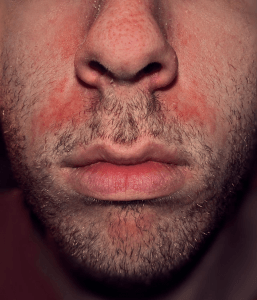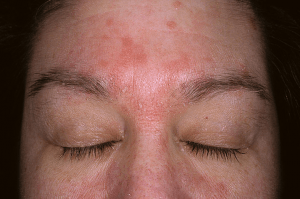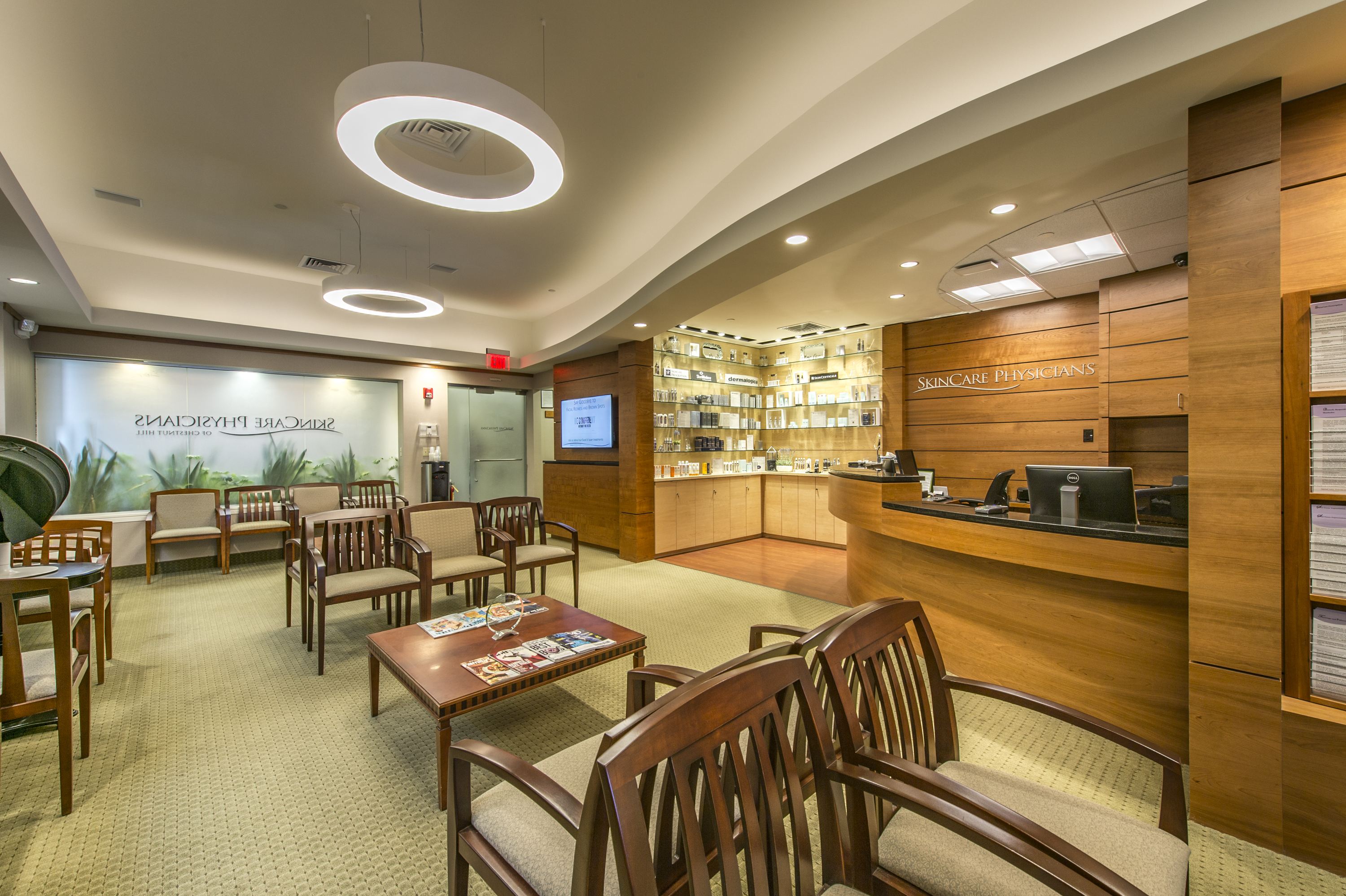- Home
- Blog
- Medical Dermatology
- Experiencing worsening flaky skin? It may not just be dry skin!
Experiencing worsening flaky skin? It may not just be dry skin!
 With the change of season upon us, you may be experiencing worsening dryness, flakiness and redness on your face and/or scalp. This may not just be dry skin, but seborrheic dermatitis, a very common skin condition that affects 1 to 5% of the general population and that our dermatologists near Boston see regularly.
With the change of season upon us, you may be experiencing worsening dryness, flakiness and redness on your face and/or scalp. This may not just be dry skin, but seborrheic dermatitis, a very common skin condition that affects 1 to 5% of the general population and that our dermatologists near Boston see regularly.
Changes in season or weather, but also emotional and psychological stress are usual circumstances when seborrheic dermatitis rears its head. Common areas affected are the scalp (mild forms are seen as dandruff) as well as behind or inside the ears, along the eyebrows, by the nose, cheek, chin and chest area.
A clue that you may have seborrheic dermatitis is that despite how much moisturizer you use, areas on your face still look flaky and red.
A useful tip may already be sitting in your shower:
- Apply an anti-dandruff shampoo such as Head and Shoulders, Selsun Blue, or Nizoral, not just on your scalp but on your face, especially along the brow, corners of the nose, chin and even chest.
- Leave it on for five minutes and then wash it off.
This can help reduce flares and calm the redness and flakiness.
If that doesn’t clear it, a dermatologist can prescribe either an anti-inflammatory cream or even an anti-fungal cream. Seborrheic dermatitis may be aggravated by an overgrowth of yeast called Malassezia so a topical antifungal cream can sometimes help.
 And don’t worry- it’s not contagious. But remember, unfortunately, this is not a condition that can be cured. It can recur. The good news is that with the proper tools, you can calm it down and manage it successfully.
And don’t worry- it’s not contagious. But remember, unfortunately, this is not a condition that can be cured. It can recur. The good news is that with the proper tools, you can calm it down and manage it successfully.
If you have any concerns about dryness, flakiness and redness on your face and/or scalp, contact your dermatologist at SkinCare Physicians at (617) 731-1600.
Photo source: Wikipedia and hardinmd.lib.uiowa.edu/dermnet/seborrheicdermatitis56.html



Hi! I have eyebrow dandruff. Doesn’t really itch. The skin between my eyebrows is not flaky but almost built up and textured. If I try to exfoliate that area it almost ends up bleeding and it takes days to heal. My nose is extremely dry as well. Every day. I do moisturize and use face sensitive cleansing products. I avoid hot water on my face. I’ve even applied aquaphor to the area over night and by the morning it’s gone and spot will be just as dry if I don’t reapply asap or moisturize. That only last a few hours. Nothing is changing. It seems mild whatever it is but I can’t get it to go away or at least stop for a bit. Could it be the extreme cold weather? My age(39) and or both?
Spots that recur despite over-the-counter interventions warrant an evaluation by a dermatologist. An examination would be helpful to determine the most appropriate treatment.
I have SD around my hairline but my scalp is not dry and I have no dandruff. Is this possible? I have started trying Nizoral shampoo. Can this cause some mild redness were SD is?
Seborrheic dermatitis can appear along the hairline without it impacting the rest of the scalp. Ketoconazole (Nizoral) shampoo is usually tolerated well and does not typically cause redness. Hope this helps.
Can dry skin get seborrheic dermatitis? I have red flakey things at the folds of my nose, but my skin is generally dry.
Seborrheic dermatitis commonly affects people with oily skin, however it can occur in people with dry skin too.
Is Cerave a good choice for a moisturizer with people with SebDerm? And how about The Ordinary serums like the peeling solution?
Cerave and Cetaphil are excellent brands for skin prone to seborrheic dermatitis. The Ordinary skin care line has many different products. You may want to avoid formulations containing alpha or beta hydroxy acid as they may potentially irritate skin when seborrheic dermatitis flares.
Can facial oils e.g. squalane make seborrheic dermatitis better or worse? At the moment my skin is highly irritated and most cleansers / moisturisers are stinging. I’m thinking of buying a moisturiser for super sensitive skin but it contains a high percentage of squalane.
Squalane is a modified form of squalene, a naturally occurring lipid produced by our skin cells. Studies suggest that squalane may improve dryness associated with seborrheic dermatitis and sensitive skin. Hope this is helpful.
I’ve been prescribed ketoconazole for seb derm on my face. As the skin is quite dry can I put moisturiser on first let it absorb and then apply ketoconazole after? Or apply ketoconazole first then moisturiser after? Thanks
A topical prescription works best when applied first followed by a moisturizer. You may want to confirm this with the provider who gave you the prescription and follow up if the dermatitis does not improve.
Is it okay to use moisturizers that include cetyl, benzyl, steayl alcohol and beeswax when you are suffering from seborrheic dermatitis?
Those ingredients do not tend to aggravate seborrheic dermatitis. Moisturizers containing them may be used.
Hello I have been having redness around my nose, a bit seem to be thicker and painful like having pimple. It comes and goes for a pass few months. I have Lupus and use to have rosacea. I have been using petroleum jelly, nappy rash cream, Clindamycin 1% ,Triamcinolone 0.1%and mupirocin ointment – topical 2%. It seem to be better for a day or 2 days and back to be red and thick. I feel like small pimple underneath but it is not. I have seen family doctor once and no way to see Dermatologist in my area due to the covid. I feel like I’m having Seborrheic Dermatitis. What should I try and do. I have selsun blue shampoo should I try ? What cream should I put. It is so irritating me.
The redness may be seborrheic dermatitis but may also be related to your lupus or rosacea. You can try using over-the-counter Nizoral shampoo daily on the area for one week but if there is no improvement, you should see a dermatologist. Many dermatologists now offer virtual visits through telemedicine. You can consider scheduling a telehealth appointment as an alternative to an in person visit.
Hey I’ve had dry red skin around my nose and eyebrows for a couple years without much improvement…how much is diet tied to flare ups? Thanks
That’s a very good question. A recent study found that a high fruit diet was associated with a lower risk of seborrheic dermatitis in both men and women. In contrast, a diet rich in meat, potato, and alcohol was associated with a higher risk of seborrhea in women. Although the exact reasons for this are not known, one possible explanation may be that fruits have an anti-inflammatory effect on seborrheic dermatitis.
i have been using e45 cream and some other medication the dermatologist gave me. Can i e45 cream to cetaphil moisturizing cream because it seems that cream is not working adequately throughout the day.
If you haven’t been seeing an improvement using the prescribed medication by your dermatologist, it would be best to follow up with your dermatologist to determine the appropriate next step.
Hi Dr Karen ,
I have Seborreic dermatitis condition . I use vichy dandruff shampoo on my haire and it reduce 100% my dandruff problems . but redness never goes away . except if i use cortisol . The sun exposure easily makes it worst . sunscreens burn my skin even those for sensitive skin . Cerave cream made it so red and dry. I didn’t use cetaphil … Do you think i should try ?
I would advise you see a dermatologist who could recommend the most appropriate cream for your skin.
My condition seems to be spreading with ketoderm cream. Do I stop or continue for a week?
If it’s not improving with your current treatment, it would be best to follow up with your dermatologist.
Hello, I started using ketoderm cream on my seborrheic dermatitis around my nose area. There’s a lot of flakey skin now. Is this normal?
It usually takes at least a week of application before you start to see improvement. If it persists, you should follow up with your dermatologist.
Hi, Would a chemical help the look of SD?
Thanks
Effective treatments typically include an anti-inflammatory or antifungal cream. I would recommend you see a dermatologist to help determine what would be the most appropriate therapy for you.
My son at 1.5 month was diagnosed with SD severe which is spreading to body. Applied hydrocortisone cream and the redness fade within 2-3 days. After that,I used cetaphil moisturiser for every nappy change and I felt the redness (esp in creases) increasing day by day . Is it because this moisturiser is closing the sweat glands..?any remedy to prevent it.
Hi, if the rash keeps recurring, you should follow up with your son’s dermatologist.
Hi,
How long does it take for treatment to be effective? I have been using ketoconazole cream twice a day for two weeks, flakes have improved but still red. How long to persist with this?
Can I use another anti fungal like Bifonazole instead as it is a once a day application (twice a day is a pain having to wait for it to absorb before applying makeup)
Thank you!
You should follow up with your dermatologist if the rash persists after two weeks of treatment. They can also advise you on changes in medication.
I have dry flakes near nose folds with redness. How can I overcome flaky skin besides nose?
Dry flaking around the nose can be a sign of seborrheic dermatitis. You may need to consult a dermatologist if moisturizers such as Cetaphil or Cerave creams have not helped.
I was diagnosed with Rosacea and Seborrheic Dermatitis. Can you recommend a moisturizer that wont aggravate these conditions? Thanks in advance!
Cetaphil and Cerave facial moisturizers are good options for people with rosacea and seborrheic dermatitis.
I came down with this for the first time last week. I treated the skin with a dandruff shampoo and then switched to a zinc bar because the shampoo seemed too harsh. Both seemed to work. The redness went down significantly almost immediately but now the skin is very dry. The large, scaly flakes are gone but now there is a lot of small flaky skin that seems more related to irritation from the products. Is there something I can do to reduce this/make it go away?
I agree it sounds like your skin may have been irritated from the medicated shampoo and zinc bar soap. Since the redness and large dry flakes have improved, you may discontinue the soap. Try applying a mild cleanser followed by a facial moisturizer such as Cetaphil or Cerave twice a day. If it doesn’t improve after a few days, you might want to see a dermatologist.
My dermatologist insists I have SD. My question is when I used minocycline I never suffered from facial redness. My skin does not feel dry but it is more red. Does minocycline help SD or facial redness?
Hi,
Minocycline is an oral antibiotic that can be prescribed for flares of rosacea, a condition that is often associated with facial redness. Seborrheic dermatitis does not usually improve with minocycline. Hope this is helpful.
Can Seborrheic dermatitis facial redness be treated with Pulsed Dry Laser?. My dermatologist has recommended a course of 6 sessions
Hi,
Lasers are typically not the first line treatment for redness associated with seborrheic dermatitis. Since seborrheic dermatitis is an inflammatory condition, the best approach is to apply an anti-inflammatory or anti-fungal cream to address the underlying cause. This will reduce the dryness and flaking along with redness simultaneously. Hope you find this information helpful.
My daughter, since she was a baby, have sensitive DRY skin and scalp… almost 6 month ago she started having some dandruff and I take her to the pediatrician and she said she have Seborrheic Dermatitis… I thought Seborrheic Dermatitis was a condition triggered by the excess of oils… my question is the pediatrician misdiagnosed my daughter and she just have a dry scalp or she can have SD even though she have dry skin and scalp…? Thanks!!!
Seborrheic dermatitis can occur in babies as well as adults. It has an incidence of up to 40% among infants so it is in fact quite common. Cradle cap is a term used because of the thick, greasy adherent scale on the scalp. It can be mistaken as dry skin but does not improve with moisturizers. Luckily seborrheic dermatitis tends to be self-limiting and usually disappears after 6 months to 1 year of age. It can return during puberty. Should the condition persist or worsen, you may want to consult a dermatologist. Hope this is helpful.
Hi, can facials like dermaplaning help with seborrheic dermatitis? Thank you.
The best way to treat seborrheic dermatitis is with a topical anti-inflammatory creams or topical antifungal cream such as ketoconazole cream. Facials and dermaplaning can be very helpful for superficial exfoliation and for dry skin. Seborrheic dermatitis can sometimes be confused with dry skin, but recurs despite facials and dermaplaning. If you’re not sure, have a dermatologist look at your skin to see what would be the best approach.